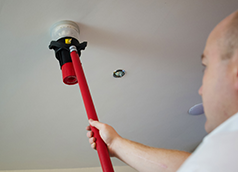Commercial fire alarms
With our fire team busy helping local businesses keep their fire alarms and risk assessments up to date, I thought it would be a good time to focus on the commercial side of fire alarms and the regulations in place. There is a full breakdown of information of what is needed in a commercial fire alarm and what we can do for you in our resources section. Here is a brief run down of the main points.
UK Statistics
According to the government statistics, the number of reported fires have decreased across the UK since last year. 192,600 reported fires were attended by the Fire and Rescue Authorities in 2012/2013, which is nearly a third lower than the year before.
22,500 fires recorded were in buildings that were not dwellings. This is 14% fewer than in 2011/2012 and 41% fewer than non-domestic premises fires in 2002/2003.
From the category of “non-domestic” fires, 3,100 of these were in retail distribution buildings, 2,600 were in industrial premises and 2,300 were in restaurants, cafes, bars and pubs.
Automatic smoke alarms were not present in 46% of these non-domestic cases in 2012/2013, however this is down almost a quarter from 2011/2012.
For those 54% that did have an alarm installed, 35% were operational and raised the alarm, 5% were operational but failed to raise the alarm, and 13% of the alarms were not in working order and failed to raise an alarm. Remember that it is important to regularly test your fire alarm and keep up to date with its services in order for it to be kept reliable.
There are many fire codes in place which are becoming more enforced every year, particularly for public buildings. For instance, BS5839 Part 1: 2013 is The British Standard for Fire Alarms in Non Domestic premises, and BS5266 is the Code of Practise for Emergency Escape Lighting. There are many resources online to help you know what regulations your business must adhere to.
BS5839 Pt1:2013 lists that:
- Residential care homes must now have automated fire service response and those with 10+ bedrooms must have addressable fire alarms.
- The lack of a Zone Plan is now regarded as “Major Non Compliance”
- There must be new stringent detector coverage for buildings with high ceilings.
- Requires the filtering of alarm calls – automated fire service response requires human confirmation.
The right Fire Alarm for You
At Keybury we provide the expertise to commission, design, install and service your fire alarm system. This process allows us to tailor your system for your specific business needs and ensure you are up to code.
The design of a fire alarm is very important and time should be taken to make sure all factors of the sensor coverage and building architecture are taken into account. Skimping at the design stage could end up costing you a lot more overall. As well as the design, make sure that your installers are properly approved as typically 88% non-approved systems that we inspect fail to meet the standards.
Common Fire alarm failings include
- No current maintenance contract in place. It is a requirement of BS5839:2002 Pt1 that systems are serviced a minimum of 6 monthly intervals.
- The 230v mains spur-point supplying power to the system does not meet the regulations.
- Non fire proof cable has been used.
- Incorrect cable fixings. Probably the most common failing is to secure the cable with plastic clips rather than metal fireproof fastenings.
- No zone schematic adjacent the control panel. There should be a zone drawing complete with a “You Are Here” marker.
- No weekly testing taking place.
There are different fire alarm categories depending on the requirements of your property. The decision of choosing which category you fall into is down to the “responsible person”.
Life Protection Categories
- L5 – An engineered solution (only very complicated buildings such as shopping centre.)
- L4 – Manual call points throughout, sounders throughout and automatic detection on escape routes and stairs.
- L3 – As L4 plus automatic detection in rooms leading onto escape routes.
- L2 – As L3 plus automatic detection in any other high risk areas (e.g. a kitchen.)
- L1 – Manual call points throughout, sounders throughout, and automatic detection throughout.
 Property Protection Categories
Property Protection Categories
- P2 – Sounders throughout and automatic detection in specified areas.
- P2M – Manual call points throughout, sounders throughout and automatic detection in specified areas.
- P1M – Manual call points throughout, sounders throughout and automatic detection throughout.
- P1 – Sounders throughout and automatic detection throughout.
At Keybury our services and installations are approved by BAFE and have achieved the highest levels of inspection. You can rest assured with us that your alarm is to a standard that complies with government requirements. For more information on what we can do for your business, get in touch to arrange a meeting with a surveyor or to schedule a Fire Risk Assessment.
